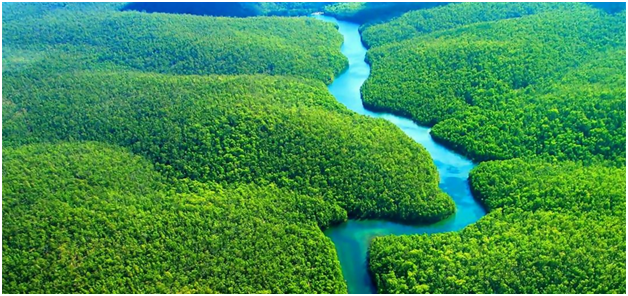Introduction
The Amazon Rainforest, often referred to as the “lungs of the Earth,” is the world’s largest tropical rainforest, spanning approximately 6.7 million square kilometers. Covering parts of nine countries in South America, with the majority in Brazil, the Amazon is a vital global resource, rich in biodiversity and crucial for climate regulation.
Biodiversity and Ecological Significance

The Amazon is home to an estimated 10% of all known species on Earth. It boasts an incredible variety of flora and fauna, including over 40,000 plant species, 1,300 bird species, 3,000 types of fish, 427 mammals, and 2.5 million different insects. This biodiversity is not only vital for ecological balance but also for the development of medicines and other biological resources.
Unique Species

Among the remarkable species found in the Amazon are the jaguar, the sloth, and the Amazon river dolphin. The rainforest’s complex ecosystem supports numerous plant species that have yet to be studied thoroughly, presenting potential for new medical discoveries.
Climate Regulation
The Amazon plays a critical role in global climate regulation. Its vast forest canopy absorbs large amounts of carbon dioxide, helping to mitigate the effects of climate change. The rainforest also influences local and global weather patterns, with its trees contributing to the water cycle by releasing water vapor into the atmosphere.
Human Impact and Deforestation

Despite its importance, the Amazon faces severe threats from human activities. Deforestation, driven by logging, agriculture, mining, and infrastructure development, has led to the loss of millions of hectares of forest. Between 2000 and 2019, the Amazon lost approximately 17% of its forest cover. This destruction not only threatens wildlife habitats but also contributes to climate change by releasing stored carbon dioxide.
Indigenous Communities

The Amazon is home to over 400 indigenous tribes, many of whom depend on the forest for their way of life. These communities possess invaluable knowledge about sustainable living and the medicinal properties of various plants. Protecting the rights and territories of indigenous people is crucial for the conservation of the rainforest.
Conservation Efforts
Numerous efforts are underway to protect and restore the Amazon. National governments, international organizations, and non-profits are working to enforce anti-deforestation laws, promote sustainable land use, and support reforestation projects. Innovative approaches, such as satellite monitoring and blockchain technology, are being used to track deforestation and ensure transparency in conservation efforts.
Global Responsibility
The preservation of the Amazon is not just a regional issue but a global one. International cooperation and funding are essential to support conservation initiatives. Consumers can also contribute by supporting sustainable products and reducing demand for goods linked to deforestation.
Conclusion
The Amazon Rainforest is a treasure of unparalleled biodiversity and a cornerstone in the fight against climate change. Protecting this vital ecosystem requires concerted efforts from governments, organizations, and individuals worldwide. As we face increasing environmental challenges, the Amazon stands as a critical battleground in the quest for a sustainable future.


